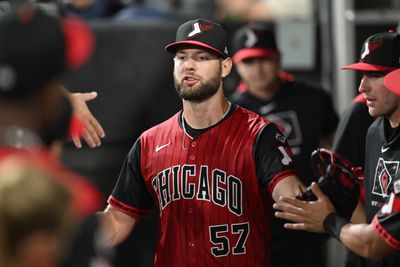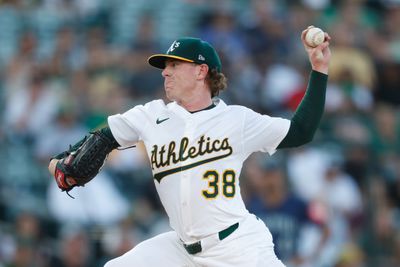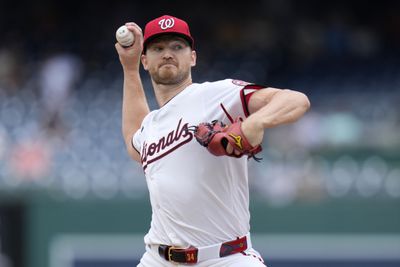
What if Craig Breslow needs to visit TJ Maxx?
Last week, I went through some top-of-the-line starting pitching options, Shark Tank style. On Monday against the Twins, Richard Fitts’ performance outlined the Red Sox’s need for starting pitching, in one form or another. The injury to Marcelo Mayer makes it difficult for the Red Sox to trade from their major league outfield, which makes it harder to land one of the big fish. While it’s not impossible to go find a nice compliment to Garrett Crochet, they might be tempted to look on the bottom shelf for some reliable innings.
So who should they look at?
Adrian Houser, Chicago White Sox, 1⁄2 Year of Control Remaining

Photo by Daniel Bartel/Getty Images
Adrian Houser isn’t the flashiest name, but he’s in the middle of the best season of his career. Over 11 starts, he has a 2.10 ERA. He doesn’t strike out a ton of hitters, but his walk rate is solid at 8%. Righties are hitting just .208 against him, thanks to his sinker. It shows good horizontal movement and a seam-shifted wake effect, leading to a 58% groundball rate and 1.5% barrel rate. His curveball earns a ton of strikes as well, both swinging and called, while his four-seam and changeup serve as two-strike offerings.
Lefties have had more success, hitting .288. He hasn’t thrown strikes at the same rate against opposite-handed hitters. His curveball and changeup combine for about 40% of his arsenal, but neither returns strikes above a 60% rate. His sinker hasn’t been hit hard, though. His four-seam also has returned strikes despite a low swinging-strike rate. Houser uses a hard slider that he could incorporate more of at the expense of his curveball or changeup. Houser isn’t someone I’d roll out early in a playoff series, but he could provide enough innings to keep the train on the tracks.
JP Sears, Homeless Athletics, 3 1⁄2 Years of Control Remaining

Photo by Lachlan Cunningham/Getty Images
This one doesn’t exactly feel like a deadline acquisition, as much as something you’d do in the offseason, but he’s an interesting arm nonetheless. He’s a left-handed pitcher with a low release and a flat fastball. Craig Breslow has shown an affinity for flat fastballs, and Sears feels like a great candidate for the Red Sox pitching program. Adding a tick or two to his fastball would go a long way towards being successful.
Sears’ biggest issue is his inability to put hitters away, especially right-handed hitters. His fastball shape should work, but he hasn’t located it up frequently enough to get outs. His slider is the most likely candidate for a swing-and-miss pitch against righties, but it blends with his sweeper at times. I’m not sure Sears is the right piece to add to this team at this time, but he is the type of arm they’ve been interested in previously.
Mike Soroka, Washington Nationals, 1⁄2 Year of Control Remaining

Photo by Jess Rapfogel/Getty Images
Soroka is another pitcher with serious platoon splits. He’s been great against right-handed hitters, but has struggled against the left side. Fortunately, he has a bad fastball that he throws a lot to lefties. It hasn’t worked, and the Red Sox are nearly certain to slash that usage should they acquire Soroka.
Soroka doesn’t have a pitch that necessarily makes sense as a replacement for the four-seam. He’s the perfect candidate to add a cutter, though. It’s not something he’s done before, but if he can add one to his arsenal as a strike-getter against left-handed hitters, it would go a long way in solving the platoon issue he has. If they don’t trade for Soroka now, keep his name in mind for the off-season.
Jose Soriano, Los Angeles Angels, 3 1⁄2 Years of Control Remaining
Jose Soriano is basically who Jordan Hicks wants to be as a starting pitcher. He throws a sinker 50% of the time, and never fully knows where it’s going. Fortunately, he throws it 97 mph with straight sideways movement. Hitters don’t know what to do with it. An absurd 79% of batted balls are on the ground.
Past that, he uses a curveball, four-seam, slider, and splitter. His curveball is in the zone some against righties. His four-seam finds the zone against lefties, as well. After that, pretty much everything is out of the zone, which causes some issues with walking hitters.
He’s also pretty platoon-neutral, which is pretty cool. You don’t have to worry about a team loading the lineup with lefties and him having no recourse, because he’s throwing 97 mph sinkers regardless of who’s at bat. Do you want a right-handed, groundball-heavy pitcher with this infield? I don’t know. Is it fun to watch him throw bowling balls as hard as he can? Hell yeah.
Trevor Bauer, Free Agent
Who let you back in here? The answer is still no.